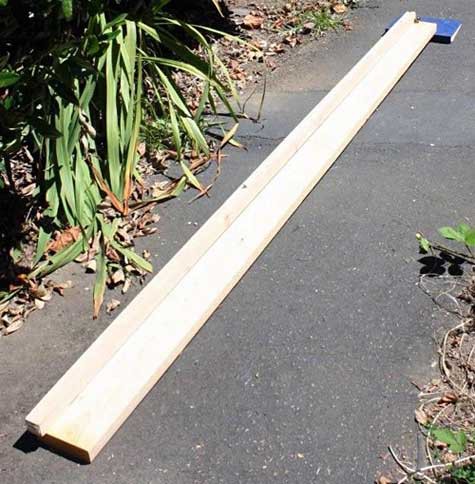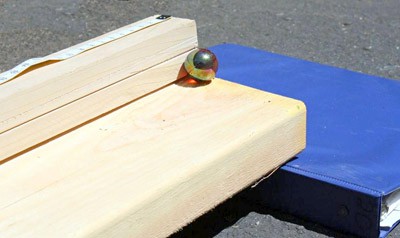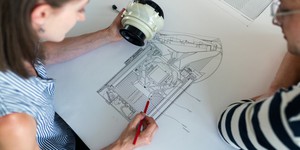Abstract
Have you ever dropped something and wondered how fast it was moving while falling? If it was something fragile, like a cell phone, you might not have been thinking about this at the time — you may have been too busy trying to grab the phone! But you probably wanted to find out just how hard it hit the ground afterwards. We know that gravity forces an object to fall, but how does this affect how quickly something falls and how hard it hits the ground? For example, did the phone move faster right after leaving your hand, or just before hitting the ground? In this science project, you will explore the relation between time and the distance an object travels while it is being constantly accelerated because of gravity.Summary
Andrew Olson, Ph.D., and Teisha Rowland, Ph.D., Science Buddies

Objective
Determine the relation between elapsed time and distance traveled when a moving object is under the constant acceleration of gravity.
Introduction
You know from experience that when you ride your bike down a hill, it is easy to go fast. Gravity is giving you an extra push, so you do not have to do all the work with the pedals. You also know from experience that the longer the hill, the faster you go. The longer you feel that push from gravity, the faster it makes you go. Finally, you also know that the steeper the hill, the faster you go. This can make some steep hills, like the one in Figure 1, below, rather dangerous to bike down. The maximum steepness is a sheer vertical drop — when objects go into free fall, and when gravity gives the biggest push of all. You certainly would not want to try that on your bicycle!
 Image Credit: Wikimedia Commons user Debbie Turner / Creative Commons Attribution-Share-Alike 2.0 Generic
Image Credit: Wikimedia Commons user Debbie Turner / Creative Commons Attribution-Share-Alike 2.0 Generic
Figure 1. The steeper the hill, the faster a person can bike down it, making it dangerous to bike down some hills. (Image credits: Debbie Turner, Wikimedia Commons, 2007)
In free fall, gravity constantly accelerates an object (increases its velocity). Specifically, gravity increases a falling object's velocity by 9.8 meters per second (m/s) with every passing second the object falls. (While velocity is measured in m/s, acceleration is measured in meters per second squared [m/s2].) So after one second, the object would be falling at a velocity of 9.8 m/s. After two seconds, the object would be falling at a velocity of 19.6 m/s. After three seconds, the object would be falling at a velocity of 29.4 m/s, and so on.
Measuring the speed of objects in free fall is not easy, because they fall so quickly. There is another way to make measurements of objects in motion under constant acceleration: use an inclined plane. An inclined plane is simply a ramp. You are making a hill with a constant, known slope. With a shallower slope, the acceleration due to gravity is small, and the object will move at a speed that is more easily measured.
In this science project, you will scientifically measure the "push" from gravity, using a marble rolling down an inclined plane and a metronome to track time.
Terms and Concepts
- Gravity
- Free fall
- Acceleration
- Velocity
- Inclined plane
Questions
- How does gravity affect the velocity of an object in free fall?
- What are the units of measurement that are used with velocity? What about acceleration?
- What is the formula for distance traveled as a function of time when an object is subject to constant acceleration?
Bibliography
For background information on inclined planes, see these references:
- Wikipedia Contributors. (2014, March 18). Inclined Plane. Wikipedia, The Free Encyclopedia. Retrieved March 25, 2014.
- The Physics Classroom. (n.d.). Inclined Planes. Retrieved March 25, 2014.
If you want to make a fancier setup to release a steel marble electrically, see the following reference:
- U.C. Regents. (1996). Acceleration. U.C. Berkeley Physics Lecture Demonstrations. Retrieved March 25, 2014.
Materials and Equipment
- A flat board, about 2 m long, to make your inclined plane. Longer is better unless you are using a video camera. You will need to either have an adult help you cut a groove straight down the middle of the board to guide the rolling marble or glue another straight piece of wood along the length of the board to act as a guide. See Figure 2, in the Procedure, for an example inclined plane.
- A wood block, book, or binder to raise up one end of your board and make an inclined plane. The block or book should be about 2.5 cm in thickness.
- Tape measure or meter stick
- Marble
- Metronome. If you do not have a metronome, you can use a metronome online or download a free application that works on a cell phone.
- Helper
- Pencil
- Lab notebook
Experimental Procedure
In this experiment, the goal is to measure the distance the marble travels in equal time intervals as it rolls down an inclined plane.
- Set up your inclined plane on a single block, book, or binder so that it has a low slope, as shown in Figure 2, below. If the slope is too high, the marble will roll too fast, and it will be too hard to make accurate measurements.
 Image Credit: Damon Kawamoto for Science Buddies / Science Buddies
Image Credit: Damon Kawamoto for Science Buddies / Science Buddies
Figure 2. Set up your inclined plane on a single block, book, or binder so that the inclined plane has a low slope, as shown here.
- Mark a starting line across the high end of the inclined plane, about 2 centimeters (cm) from the end.
- Start a metronome to keep track of equal time intervals. Have the metronome tick at 60 beats per minute (bpm), which gives you one tick every second (sec).
- Place the marble on the starting line, as shown in Figure 3, below, and hold it there.

Figure 3. Before each trial, place the marble on the starting line, as shown here, and hold it there.
- In time with a tick, release the marble, being careful not to give it a push as you let go.
- Have your helper mark where the marble is at the first tick after release.
- Measure the distance (cm) from the starting line.
- Record the distance in a data table in your lab notebook. In your data table, be sure to include the time at which you took the measurement (one tick, or 1 sec) along with the distance.
- Repeat steps 4–8 at least 9 more times, for a total of at least 10 trials.
- Next repeat steps 4–9 but this time in step 6 have your helper mark where the marble is at the second tick (after 2 sec).
- Be sure to again measure and record the distance the marble travels in each trial (but this time for 2 sec instead of 1 sec).
- Keep repeating steps 4–9 for each successive tick (second), making 10 measurements for each tick, until the tick when the marble goes past the end of the inclined plane.
- Calculate the average distance the marble traveled over 10 trials for each tick. Record your results.
- Make a line graph of your results showing the distance traveled over time as the marble rolled down the inclined plane. Place the average distance traveled (in cm) on the y-axis and the time (in sec) on the x-axis.
- Make a second line graph of your results showing the distance traveled over time squared as the marble rolled down the inclined plane. Again, place the average distance traveled (in cm) on the y-axis, but now place time squared (in sec2) on the x-axis.
- Analyze your results and try to draw some conclusions.
- How does the distance the marble travels change as it rolls down the inclined plane for a longer amount of time?
- Compare your two graphs. How are they similar? How are they different?
- What do you think your graphs tell you about the effect of gravity on the velocity and acceleration of a marble as it rolls down an inclined plane?
Ask an Expert
Variations
- You could try repeating this science project with the metronome set to a different speed, such as 120 bpm (or two ticks every second). How does changing the metronome speed affect your results?
- Another way to see the relationship between time and distance traveled with constant acceleration is to use the distance traveled during the first "tick" as the distance unit instead of centimeters. How many of these distance units does the marble travel by the second tick? By the third? By the fourth and fifth?
- Does the mass of the marble affect its acceleration? Try the experiment with marbles of different masses. Or, even better, compare a steel marble (e.g., a pinball or a large ball bearing) with a glass marble of the same diameter. Use a digital scale such as the Fast Weigh MS-500-BLK Digital Pocket Scale to weigh each marble. Is the acceleration the same or different for the marbles with different masses?
- For another method of measuring distance traveled and velocity of an object rolling down an inclined plane, see the Science Buddies project, Distance and Speed of Rolling Objects Measured from Video Recordings.
- Use your measurements to calculate the approximate velocity of the marble at each tick. As an example, to calculate the average velocity at the second metronome tick, take the distance the marble has traveled by the second tick, and subtract the distance the marble traveled by the previous tick. Divide the result by the amount of time per tick. Repeat this calculation for several successive time points to see how velocity changes as the marble rolls down the ramp. Make a graph of velocity (y-axis) vs. time (x-axis). Does this graph look more like the distance vs. time or the distance vs. time squared graph?
- One reason a marble was chosen for this experiment was to minimize the frictional forces which counteract the acceleration of gravity. Try repeating the experiment with other rolling objects (e.g., a toy car with the same mass as the marble) or different surface treatments (e.g., smooth, waxed surface, vs. rough, sandpapered surface). Can you detect a decrease in acceleration due to increased friction?
- For more advanced students:
- If you have studied trigonometry, you should be able to derive a formula that describes the acceleration, a, of the marble as function of the angle, Θ, of the inclined plane (see Henderson, 2004).
- If you have studied calculus, you should be able to explain both velocity and acceleration as the first and second derivatives, respectively, of distance traveled with respect to time. Conversely, you should be able to explain velocity and distance traveled at a given time as the first and second integrals, respectively, of acceleration with respect to time.
Careers
If you like this project, you might enjoy exploring these related careers:









